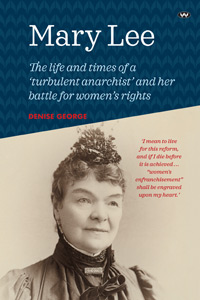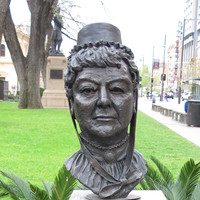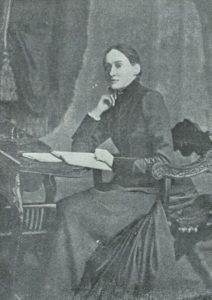Book Review: Mary Lee: The Life and Times of a ‘Turbulent Anarchist’ and Her Battle for Women’s Rights
Sharon Crozier-De Rosa
Mary Lee: The Life and Times of a ‘Turbulent Anarchist’ and Her Battle for Women’s Rights by Denise George (South Australia: Wakefield Press, 2018 270pp. $34.95) ISBN: 9781743055960 in Lilith: A Feminist History Journal, Number 25, 2019, pp.109-110.

As a female who similarly migrated from Armagh to Adelaide, and who came to be interested in woman suffrage – researching and writing about it rather than having to actively campaign for it, thankfully – I have always been intrigued by the figure and life of Mary Lee. With this book, Denise George uses her considerable skills to flesh out the life of this little-known activist. What results is a beautifully written, interconnecting biography of Mary Lee with a history of South Australia and its woman suffrage movement.
Mary Lee was born in Ireland in 1821 (a minor gripe of mine being that George refers to Lee’s birthplace as Northern Ireland almost a century before Ireland was partitioned and that state was created). By the time she arrived in Adelaide in 1879, with her daughter Evelyn (Eva), she was fifty-nine years old and a widow. She travelled across the world to nurse her youngest son, Ben, who was tragically fatally ill. She stayed in Adelaide and gained a reputation as a determined and resilient, but also controversial and contrary, social and political activist. She spearheaded the fight for woman suffrage which saw South Australia become the first Australian state to grant women the vote in 1894 (Lee was piqued that New Zealand beat South Australia to the post by granting woman suffrage the year before (p.162)). Indeed, her tireless campaigning, and that of her fellow activists, led to South Australia being the first parliament to grant women the simultaneous right to vote and right to stand for parliament. Yet, as Mary Lee foretold, and George affirms (p.176), for a very long time, it was the men who held positions of power and who could grant women the right to vote who were remembered in the story of the spread of democracy in South Australian. Many of the female activists like Lee, working doggedly from a position of disenfranchisement, were overshadowed in, if not entirely written out of, histories of the franchise.
Lee’s experiences are recorded as faithfully as the records allow. She is presented as a diligent and resolute activist motivated by religious and reformist zeal. But she is also portrayed as a migrant widow haunted by the very real spectre of genteel poverty. Perhaps the most lasting impression of Lee that I took away from the book was her strong-mindedness and the subsequent (what we would call today) trolling of her in the popular press. As George explains it, Lee was characterised as ‘an abrasive loud mouth’ who ‘attracted ill will’ (p.80). Her frequent strongly-worded, passionate letters to the press on the issue of reform were met by seemingly relentless efforts to humiliate her (p.160).
Historians of biography remind us that biographers are generally divided into different camps. Whereas some use individual lives as a lens through which to examine wider historical events and processes, others contend that biography should focus on the individual life with historical context playing only a limited role.[i] George’s biography of Mary Lee lies somewhere in-between – as befits the subtitle ‘life and times’. She uses census data, parliamentary proceedings, newspaper articles and Lee’s ‘voluminous letters to the press’ (p.x) to reconstruct Lee’s feminist and labour activisms. Lee’s social and political work is situated in the wider context of the disease, death, poverty, inequality, appalling labour conditions and, of course, the pain of indigenous dispossession that characterises colonial Australia. However, George also acknowledges reading ‘between the lines’ (p.x) – for example, between the lines of those voluminous letters – to try to access what is not publicly available. In doing so, she also draws on her experience as a creative writer. She creatively weaves stories about Lee’s doings with those about her particular locality at the time. She adds colour, conjuring up evocative depictions of time and place, inviting us to imagine Lee’s reaction to her surroundings. This creative licence is understandable, perhaps even essential for the task of writing this woman’s biography, given George’s claim in the book’s press releases that more experienced biographers would likely not have pursued Lee’s story because of the limited research material available. She could have fictionalised the story but desisted because she wanted to ‘keep it real’. What results is a ‘real’ story with fictionalised aspects; a ‘real’ story with a few ‘it’s easy to imagine’ elements in it.
The book fittingly ends with Lee’s own words: ‘There is no finality in human progress’ (1893). In order to demonstrate the astuteness of this assertion, George leaves us with the image of the recent women’s marches, initiated in 2017 to protest Donald Trump’s inauguration as president of the US. These marches mirror those that took place in countries like the US and Britain at the beginning of the twentieth century to campaign for the right to vote. The need for movements for reform generally – and for feminist reform specifically – is still very much in evidence. So too is the need for scholars – like George – to continue to work to make sure that feminist activists of the past are not consigned to history’s rubbish heaps; that their lives and works are reconstructed even, or especially, in the face of difficulty, such as that brought about by scant records.
Sharon Crozier-De Rosa
University of Wollongong
[i] For a recent outline of these debates, see Daniel R. Meister, ‘The Biographical Turn and the Case for Historical Biography’, History Compass, Volume16, Issue1, January 2018, pp.1-10.




